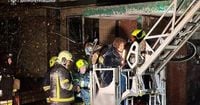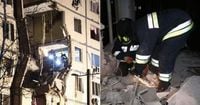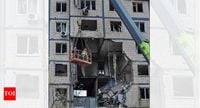In the early hours of November 9, 2025, the city of Dnipro in eastern Ukraine was jolted awake by the deafening impact of a Russian drone slamming into a nine-story apartment building. As residents slept, three people lost their lives and twelve others, including two children, were wounded, according to multiple reports from Reuters, AP, and Ukrainian emergency services. That same night, a worker at an energy company in Kharkiv was also killed in a separate strike, bringing the death toll to four from this latest wave of attacks.
These strikes were part of an extensive Russian offensive that saw more than 450 drones and 45 missiles—32 of them ballistic—launched across Ukraine, as detailed by President Volodymyr Zelenskyy and Ukrainian military officials. The Ukrainian air force reported that 25 locations were hit in total, stretching from the capital Kyiv to the central Poltava region and as far north as Kharkiv. The barrage represented one of the most intense nights of attacks since the full-scale invasion began in February 2022.
Authorities described a harrowing scene in Dnipro, Ukraine’s fourth-largest city. Emergency services rushed to the apartment building, where a fire had broken out and several apartments were destroyed. Rescuers recovered the bodies of three individuals from the rubble. Among the injured were two children, underscoring the indiscriminate nature of the attack. In Kharkiv, the strike on an energy facility claimed the life of a worker, further highlighting the dual focus of these assaults: civilian populations and critical infrastructure.
Ukraine’s response was swift and, by some measures, effective. The air force announced that its defenses managed to shoot down and neutralize 406 drones and nine missiles, a testament to the country’s growing air defense capabilities. Still, the sheer scale of the attack overwhelmed many regions. Ukrainian Energy Minister Svitlana Grynchuk reported that authorities were forced to switch off power in several areas to contain damage and prevent further casualties.
The impact on Ukraine’s energy grid was profound. State-owned energy company Tsentrenergo, which generates about 8% of the nation’s power, said the attacks were the largest on its facilities since the war began. In a statement cited by Reuters, Tsentrenergo warned, “The last strike was not even a month ago and the enemy has now struck all our generating capacity at the same time. The stations are on fire!” As a result, Tsentrenergo halted operations at its plants in Kyiv and Kharkiv regions, while thermal power stations in Donetsk were also knocked offline.
Prime Minister Yulia Svyrydenko, posting on X (formerly Twitter), confirmed that “several major energy facilities” around Kharkiv, Kyiv, and Poltava had suffered significant damage. The coordinated strikes on energy infrastructure—coming as winter approaches—are viewed by Kyiv officials as a deliberate attempt by Moscow to “weaponize winter,” denying civilians heat, light, and running water during the coldest months. Russia, for its part, has repeatedly claimed that its targets are limited to military and energy sites supplying Ukrainian forces. The Kremlin’s Defense Ministry asserted that these nighttime strikes hit “military and energy sites,” but the grim toll among civilians tells a more complicated story.
President Zelenskyy, speaking on Telegram, called for a robust international response. “For every Moscow strike on energy infrastructure—aimed at harming ordinary people before winter—there must be a sanctions response targeting all Russian energy, with no exceptions,” he urged. The Ukrainian leader’s demand for intensified sanctions reflects mounting frustration over the ongoing devastation wrought by Russian attacks and the perceived inadequacy of existing international pressure on Moscow.
The barrage was not limited to Ukrainian territory. Russian authorities claimed that their forces repelled 82 Ukrainian drones overnight, including eight over the southern Volgograd region. Governor Andrei Bocharov said a “massive” strike knocked out power in parts of Volgograd’s northwest, though no casualties were reported. In the neighboring Saratov region, two civilians were wounded when a Ukrainian drone strike blew out windows in an apartment building, according to Governor Roman Busarin. These cross-border strikes illustrate the escalating tit-for-tat nature of the conflict, with both sides targeting each other’s energy infrastructure in what has become a war of attrition.
Meanwhile, on the diplomatic and military front, tensions continued to mount. Russian Foreign Minister Sergey Lavrov announced that work had begun on President Vladimir Putin’s order to prepare plans for a possible Russian nuclear test, as reported by state news agency Tass. Putin’s directive came just days after statements by former U.S. President Donald Trump, which appeared to suggest that Washington might consider restarting its own atomic tests for the first time in three decades. The specter of renewed nuclear testing has injected a fresh layer of anxiety into an already volatile situation.
On the ground, fighting near the strategic city of Pokrovsk in eastern Ukraine has intensified. The city, part of the so-called “fortress belt” of Donetsk, is crucial to Ukraine’s defense and could play a key role in shaping U.S. policy and influencing the course of peace negotiations, according to analysts cited by AP. Russian forces claimed on Saturday to have encircled both Pokrovsk and Myrnohrad, as well as Ukrainian defenders in the key railway hub of Kupiansk in the Kharkiv region. Kyiv has not immediately responded to these claims, and independent verification remains elusive.
For ordinary Ukrainians, the latest strikes are a grim reminder of the war’s relentless toll. The near-daily attacks on civilian and energy infrastructure have left many without basic services, forced to endure blackouts and the constant threat of violence. The international community, meanwhile, faces renewed questions about how to respond to Russia’s escalating tactics and whether existing sanctions are sufficient to curb Moscow’s ambitions.
As winter approaches, the stakes for Ukraine’s civilian population grow ever higher. The deliberate targeting of power plants and residential buildings suggests a strategy not just of military conquest, but of breaking the will of a nation through hardship and fear. Yet, as the events of November 9 show, Ukraine’s resolve—and the world’s attention—remain unbroken, even as the war grinds on with no end in sight.






